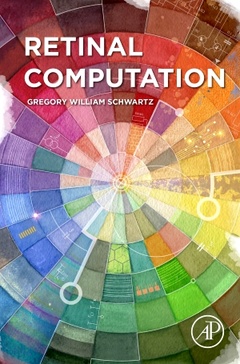Retinal Computation
Auteur : Schwartz Greg

Retinal Computation summarizes current progress in defining the computations performed by the retina, also including the synaptic and circuit mechanisms by which they are implemented. Each chapter focuses on a single retinal computation that includes the definition of the computation and its neuroethological purpose, along with the available information on its known and unknown neuronal mechanisms. All chapters contain end-of-chapter questions associated with a landmark paper, as well as programming exercises. This book is written for advanced graduate students, researchers and ophthalmologists interested in vision science or computational neuroscience of sensory systems.
While the typical textbook's description of the retina is akin to a biological video camera, the real retina is actually the world?s most complex image processing machine. As part of the central nervous system, the retina converts patterns of light at the input into a rich palette of representations at the output. The parallel streams of information in the optic nerve encode features like color, contrast, orientation of edges, and direction of motion. Image processing in the retina is undeniably complex, but as one of the most accessible parts of the central nervous system, the tools to study retinal circuits with unprecedented precision are up to the task. This book provides a practical guide and resource about the current state of the field of retinal computation.
PART 1 Luminance 1. Photon detection - Gregory Schwartz 2. Luminance adaptation - Gregory Schwartz and Jared Levine 3. Absolute luminance detection - Gregory Schwartz
PART 2 Contrast 4. Contrast sensitivity - Gregory Schwartz 5. Contrast adaptation and sensitization - Gregory Schwartz 6. Contrast suppression - Gregory Schwartz
PART 3 Spatial features 7. Texture sensitivity - Gregory Schwartz 8. Surround suppression - Gregory Schwartz 9. Object localization - Gregory Schwartz and Devon Greer 10. Orientation selectivity - Gregory Schwartz
PART 4 Motion 11. Direction selectivity - Gregory Schwartz, Gautam B. Awatramani, and Ben Murphy-Baum 12. Object motion sensitivity - Gregory Schwartz and David Swygart 13. Motion anticipation - Gregory Schwartz 14. Threat detection - Gregory Schwartz
PART 5 Other computations 15. Periodic sequence entrainment - Gregory Schwartz 16. Color processing - Gregory Schwartz
- Provides a practical guide on the field of retinal computation
- Summarizes and clearly explains important topics such as luminance, contrast, spatial features, motion and other computations
- Contains discussion questions, a landmark paper, and programming exercises within each chapter
Date de parution : 08-2021
Ouvrage de 340 p.
15.2x22.8 cm
Thème de Retinal Computation :
Mots-clés :
Vision; Neuroscience; Retina; Circuits; Computational Neuroscience; Sensory Systems



